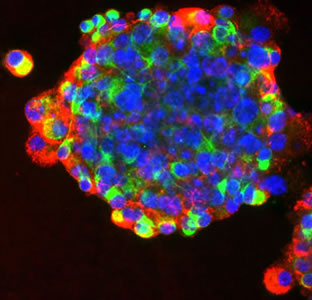UTSA stem cell research provides hope for infertile cancer survivors

Photo from Johns Hopkins Medicine PodBlog

Photo from Johns Hopkins Medicine PodBlog
(Nov. 29, 2012) -- Radiation and chemotherapy can pack a powerful punch against all kinds of cancers. Those who survive, however, are often left with bad news: Their treatments have rendered them infertile.
A UTSA professor has now demonstrated that it is possible to remove testicular stem cells from a monkey prior to chemotherapy, freeze them and later, after cancer treatments, transplant these cells where they can restart sperm production and restore fertility.
UTSA Assistant Professor Brian Hermann worked in collaboration with researchers at the University of Pittsburgh School of Medicine Magee-Women's Research Institute (MWRI) on a technique that might be used to make male cancer patients fertile using their own spermatogonial stem cells.
"This is a really exciting milestone for this research," said John McCarrey, director of the San Antonio Cellular Therapeutics Institute. "This is the first time that anybody has been able to show the concept works in a primate model, and that is an important step in moving the research forward to clinical trials."
While men facing cancer treatments, which could cause infertility, are able to store their own sperm for future use in the fertility clinic, this is not an option for boys before puberty who are not yet making sperm. But, all pre-pubertal boys have spermatogonial stem cells (SSCs) in their testes, which could be used for transplantation.
The concept of using spermatogonial stem cells to restore fertility was first introduced in the mid-1990s by University of Pennsylvania scholar Ralph L. Brinster. Since that time, scholars have been working to demonstrate the concept is viable.
But, more work is required. The research must overcome a number of hurdles before it can become a common clinical practice.
"This research demonstrates the proof of principle -- that the concept works in primates and has a good chance of working in humans," said Hermann. "We need to better understand the optimal timing of transplantation, how to prepare testicular stem cells for transplantation and make them safe for transplantation, and how to maximize their ability to restart sperm production."
But, it's difficult for researchers to know when clinical trials will begin, since the removal and storage of spermatogonial stem cells currently is a rare practice worldwide.
"There are currently only a handful of clinics around the world that will remove and preserve testicular stem cell samples from pre-pubertal patients, and that limits the availability of candidates," said Hermann. "Until more clinics get on board and save stem cells for patients, we are limited in what we can do to test transplantation in clinical trials."
Hermann joined the UTSA College of Sciences faculty in summer 2011, following a post-doctoral fellowship at MWRI alongside Associate Professor Kyle Orwig. At UTSA, he is continuing to focus his research on basic and translational studies of spermatogonial stem cells to preserve fertility in boys treated for cancer and related diseases.
"For a long time, oncologists have been unable to address the long-term consequences of life-saving chemotherapy and radiation treatments such as infertility," said Hermann. "That is now beginning to change as laboratory research such as this study provides new experimental options for patients facing infertility after cancer."
Hermann's research is funded by the Eunice Kennedy Shriver National Institute of Child Health and Human Development, the Max and Minnie Tomerlin Voelcker Fund, and UTSA.
Learn more about Hermann's research and read his article "Spermatogonial Stem Cell Transplantation into Rhesus Testes Regenerates Spermatogenesis Producing Functional Sperm" in the current issue of Cell Stem Cell, the nation's leading stem cell journal.
Events
The UTSA Office of Undergraduate is proud to celebrate National Undergraduate Research with an annual event sponsored by the (OUR) featuring students will showcase undergraduate student research and creative endeavors from all disciplines across campus.
Various LocationsDía en la Sombrilla, formerly Fiesta UTSA, is a festival hosted each spring as a part of Fiesta® San Antonio events. Sponsored by Roadrunner Productions, the event features music, food, confetti, games, event t-shirts, and more.
Sombrilla Plaza and Central Plaza, Main CampusFiesta Arts Fair features contemporary art from more than 100 artists from across the U.S., Fiesta favorite foods, drinks, live music by local and regional performers, and a Young Artists Garden providing opportunities for budding artists to learn, explore and express their creativity.
UTSA Southwest CampusJoin the PEACE Center and Wellbeing Services for Denim Day, a day of learning about the importance of consent and why we wear denim on the last Wednesday of the month each April during Sexual Assault Awareness Month. Stop by our Denim Day display to take a photo in front of our Denim Wall, spin the "Is It Consent?" Wheel, and get a Concha or goodie.
Student Union Window Lounge, Main CampusLearn to use Zotero®, a citation manager that can help you store and organize citations you find during your research. Zotero can generate bibliographies in various styles, insert in-text citations and allow you to share sources with collaborators.
Virtual EventThis event is to achnowlege the graduating seniors and induct the new cohart of scholars to our program.
North Paseo Building (NPB 5.140,) Main CampusCelebrate the accomplishments of College of Education and Human Development, College for Health, Community and Policy, College of Sciences and University College.
Alamodome

